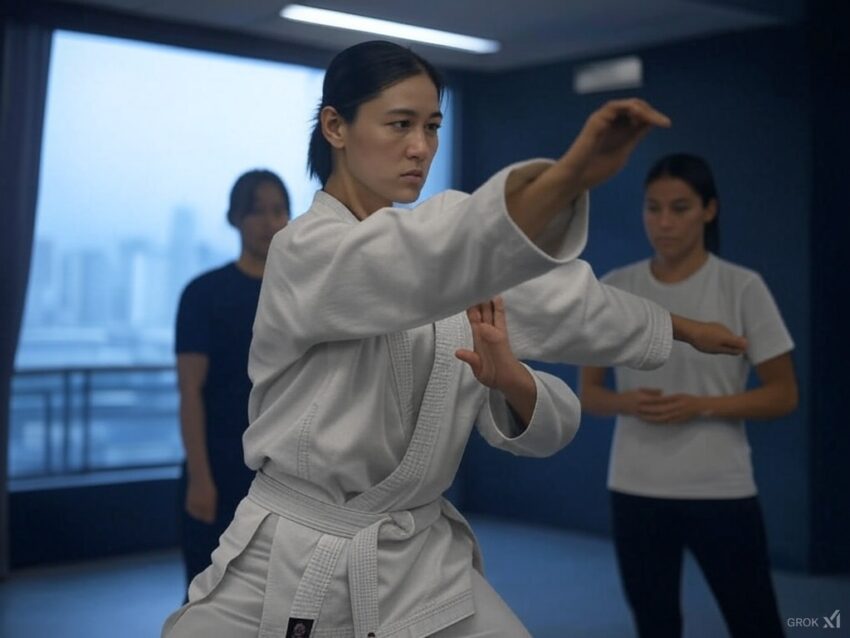Empower & Protect: Women’s Self-Defense with Jujiken-Jutsu
Introduction: Why Jujiken-Jutsu for Women?
Welcome to a journey of empowerment and protection. Jujiken-Jutsu, a self-defense system based on Koryu (old-school) Japanese martial arts of the Musashi Shinobi (Ninja) Samurai Clan, blends joint manipulation, precise strikes, and weapon-inspired tactics to equip you for real-world threats. Born from the need to survive, it’s perfect for women—no size or strength required, just smart, efficient moves. This book isn’t about turning you into a fighter; it’s about giving you the tools to stay safe, stand tall, and trust yourself. For best results, pair these pages with hands-on training from a certified instructor. Let’s begin with a legacy of the Musashi Ninja Clan and history of the Musashi Shibata-ryu Kojutsu art of Jujiken-jutsu.
Chapter 1: The Mindset of Self-Defense
Self-defense starts in your head. Jujiken-Jutsu teaches you to think like a protector: confident, focused, ready. Fear is natural—use it to sharpen your senses, not freeze you. The philosophy here is simple: control the situation, redirect aggression, neutralize danger. Predators look for hesitation; don’t give it to them. Learn to spot trouble—shifty eyes, too-close approaches, gut feelings—and trust your instincts. Confidence isn’t loud; it’s a quiet power that says, “I’m not an easy target.”
Chapter 2: Situational Awareness and Prevention
The best defense is never needing one. Awareness is your shield. At home, lock doors and know your exits. On the street, scan for odd behavior—someone lingering too long, matching your pace. In crowds, keep your bag close and your head up. If tension rises, use a firm “Back off” with steady eye contact to de-escalate. Walking alone? Stick to lit areas, phone tucked away. Prevention isn’t paranoia—it’s owning your space and staying one step ahead.
Chapter 3: The Basics of Jujiken-Jutsu Stance and Movement
Your body is your weapon, and it starts with stance. Stand with feet shoulder-width apart, knees soft, hands up near your chest—ready but relaxed. Move like water: shift side to side, pivot away from danger. Practice stepping back while keeping balance; it’s your escape hatch. Warm up with arm circles and quick steps to loosen up. Jujiken-Jutsu isn’t about muscle—it’s about using angles and timing to outsmart an attacker.
Chapter 4: Striking Fundamentals—Your Natural Weapons
You don’t need fists of steel—just know-how. Open-hand strikes to the nose stun fast; aim with your palm’s heel. Short punches to the throat or jaw work too—keep your wrist straight. Elbows are gold up close; swing them sideways into ribs. For kicks, drive your knee to the groin or stomp their shin. Practice on a pillow: 10 reps each, fast and hard. These aren’t fancy—they’re your ticket out of trouble.
Chapter 5: Defending Against Grabs and Holds
Grabs happen—be ready. Wrist caught? Twist your arm toward their thumb and yank free. Choked from the front? Tuck your chin, step back, and slam their arm down with both hands. Rear choke? Drop low, turn, and elbow their gut. Hair pulled? Grab their hand, press it to your head, and kick back. Practice with a friend (gently!): 5 escapes each. Jujiken-Jutsu turns their grip into your advantage.
Chapter 6: Countering Common Attacks
Attacks come fast—react faster. Slap or punch coming? Raise your forearm to block, then counter with a palm strike. Bear hug from behind? Drop your weight, twist, and knee their thigh. On the ground? Kick their knees, roll away, and scramble up. Combine moves: block, strike, escape. Practice this flow 10 times—muscle memory saves you when panic hits.
Chapter 7: Using Everyday Objects as Weapons
Anything’s a tool in Jujiken-Jutsu. Keys between your fingers? Jab an eye. Purse heavy with stuff? Swing it at their head. Pen in hand? Stab their arm. Toss your phone to distract, then run. Look around now—spot three things you could use. Practice swinging a bag or poking with a pen (safely). It’s not about fighting—it’s about buying seconds to get away.
Chapter 8: Defending Against Armed Threats
Weapons are scary—prioritize escape. Knife at you? Step aside, grab their wrist with both hands, and twist while kicking their knee. Blunt object swinging? Duck, redirect their arm, and strike their face. Don’t wrestle for it—control, hit, run. Practice the twist-and-kick slowly 10 times. This is risky stuff; only fight if cornered. Safety first.
Chapter 9: Multiple Attackers and Group Scenarios
Two or more? Don’t freeze. Move constantly—line them up so one’s in front of the other. Hit the loudest one first: palm to nose, knee to gut. If another grabs, lock their elbow and push them into someone else. Goal’s not to win—it’s to bolt. Practice pivoting and striking in a circle 5 times. Chaos is messy; stay sharp and keep breathing.
Chapter 10: Emotional and Physical Recovery After an Attack
It’s over—now what? Your hands might shake; that’s adrenaline dumping. Breathe deep, find safety, call for help. Guilt or “what-ifs” might creep in—talk to someone. Legally, you’re allowed to defend yourself (check local laws). Ice bruises, rest, and let yourself heal. You survived—that’s strength. Write it down if it helps; you’re not alone.
Chapter 11: Training for Life—Making Self-Defense a Habit
Skills fade—keep them sharp. Solo drill: 10 strikes, 5 escapes, daily. Find a Jujiken-Jutsu class (or any self-defense group) near you. Practice with a buddy: block and counter, slow and safe. This isn’t just moves—it’s confidence in your bones. Make it yours, every day.
Conclusion: Your Power, Your Safety
You’ve got the tools: awareness to spot trouble, moves to stop it, guts to recover. Jujiken-Jutsu isn’t about being invincible—it’s about trusting you’re enough. Walk taller, breathe easier. You’re ready—not just to survive, but to thrive.
Appendices
- Glossary: Stance (balanced posture), Joint Lock (control hold), Redirect (shift their force).
- Resources: Look up self-defense videos, books like The Gift of Fear, local dojos.
Safety Checklist: Keys ready, phone charged, route planned.
